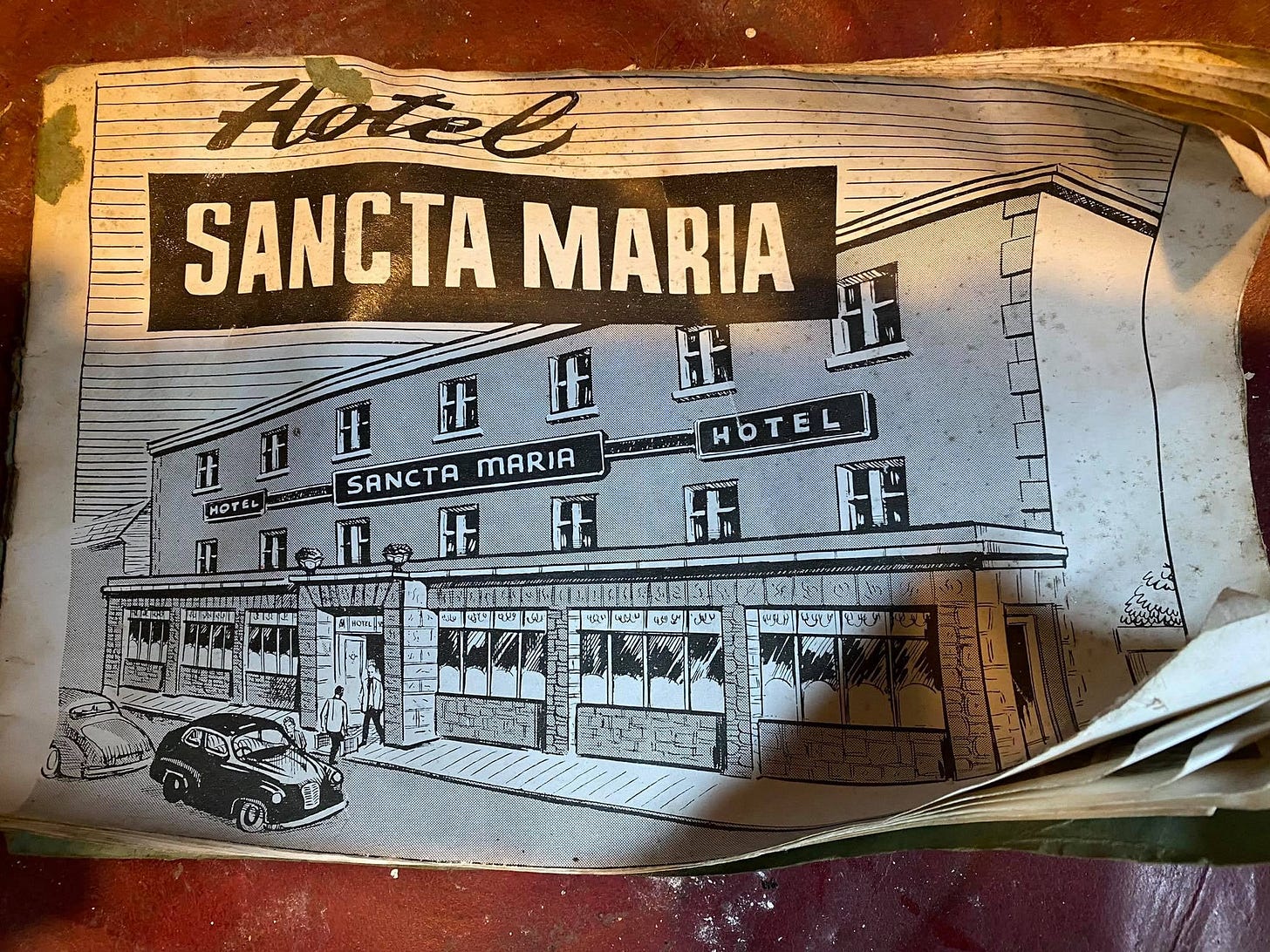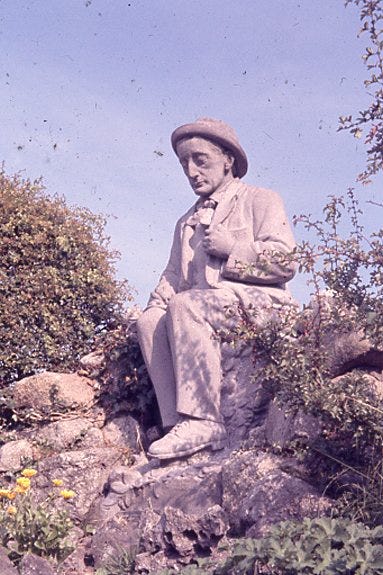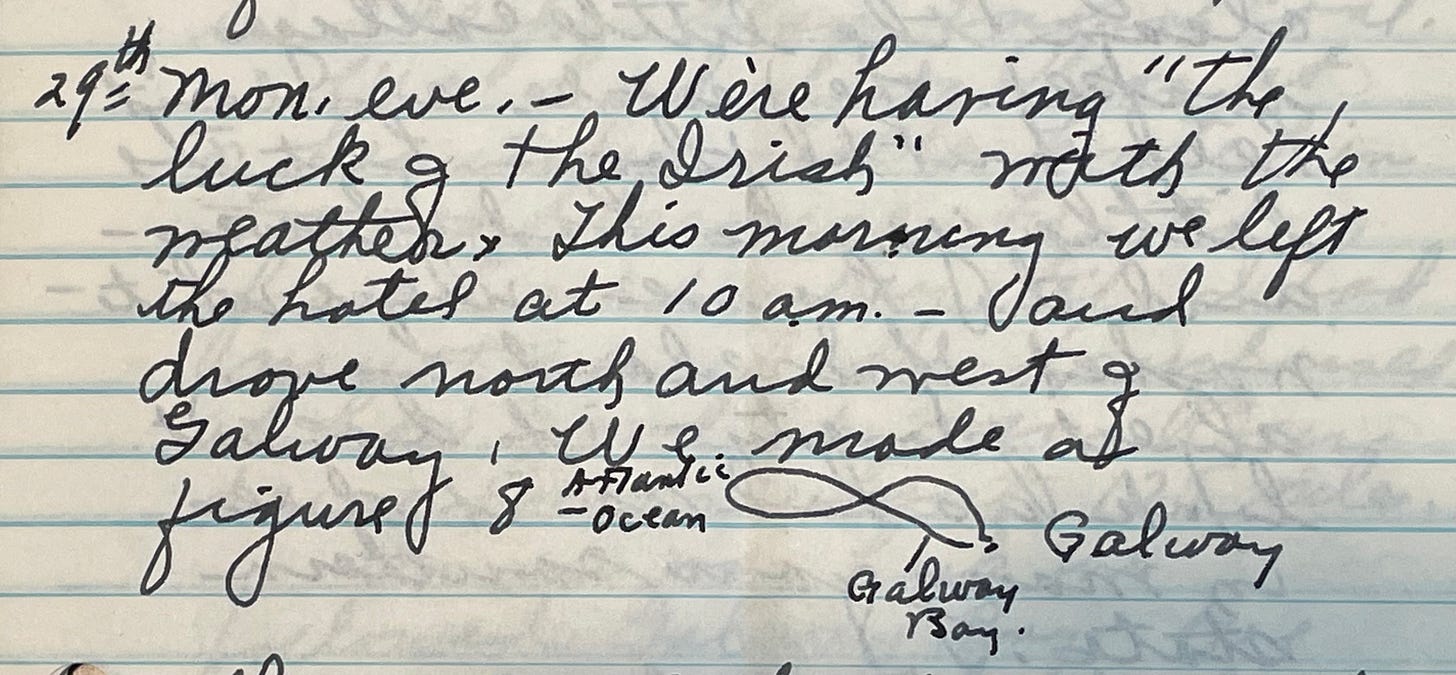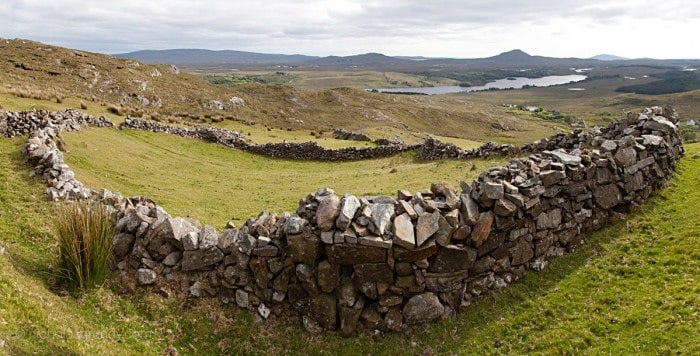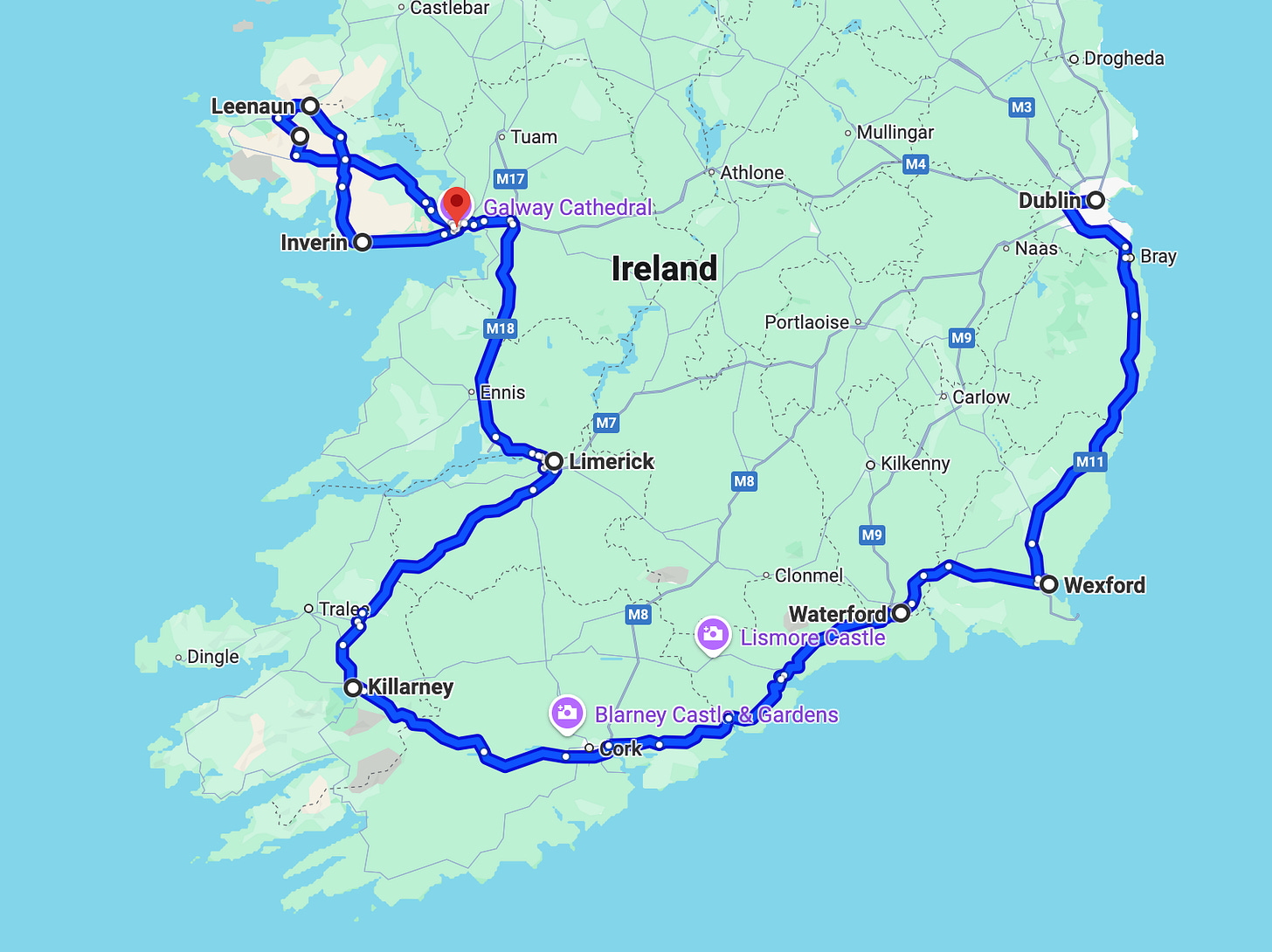#14: July 1963, Southwest Ireland
From Killarney to Galway and Connemara via Limerick, and back to Dublin
As this entry begins, K and her friends have just traveled along the south of Ireland from Dublin to Killarney, and are continuing on from there.
Sun. p.m.
We arrived at our hotel—the Sancta Maria—soon after four o’clock. it was another day of interesting scenery—quite different and not so spectacular. We drove through the most fertile valley of Ireland. Most of the cottages are very small—very neat—usually white-washed. They all seem to have a fenced-in plot around them—quite often of stone—and some flowers. I wouldn’t know how many castle ruins we passed.
We had lunch in Limerick—the Royal Cruise Hotel. The town was jammed with people. The churches were just letting out, and there was a Hurling match to be played. Hurling is played with sticks similar to hockey sticks with a ball a bit larger than a tennis ball.
Cruises Royal Hotel was a historic landmark in Limerick. On this map, you can see its location marked toward the bottom left. It was demolished in 1991 to make way for a new pedestrian shopping street (called Cruises Street in its honor).
Hurling is a distinctively Gaelic Irish game, and CNN listed the All-Ireland Senior Hurling Championship as second—behind the Olympic Games—of 10 sporting events you have to see live. This might give you a sense of the energy in Limerick that day, as the match being played that day—July 28, 1963—was the Munster finals: the Minor championship match between Limerick and Tipperary at 2 p.m. and the Senior championship match between Waterford and Tipperary at 3:30. The winners went on to the All-Ireland Finals—here are some excerpts from the Waterford-Kilkenny match that took place on Sept. 1 in Dublin.
People were “taking”—instead of cabs—a flat wagon, big as a hay wagon floor—to the game. Then there were “traps” and carts similar to the jaunting carts of Killarney. The band went by—gay green kilts, red tops, and the “Tinkers” were there begging. It was all gay and fun.
Irish Travellers are an ethnic community who have been nomadic for generations. They were often called “Tinkers” due to their work in tinsmithing. Beginning at about the time K was visiting, the government began a controversial program of settlement, and the vast majority have come to live in houses or stationary caravans. Here’s a fascinating photo essay on their lives in these communities.
Because of the races being held in Galway we can’t stay at the regular hotel used. This is a small hotel—we’re in a small room—but have a bath. Think the hotel is listed with six—so we love two! The bathroom is carpeted, but we have no chair in the room. Don’t believe there is space to put one. I haven’t decided where I’ll put my bag to open it.
According to this article, horse racing in County Galway at the present location goes back to 1869, and the Galway Races has become one of the most famous race meetings in the world. The year K was there, the races were televised for the first time and President Kennedy attended.
I found a story about the Hotel Sancta Maria, which was run by the McTigue family. It became famous in 1951 when the cast of the film The Quiet Man stayed there. Unfortunately, a fire broke out about 6 months after K’s visit that devastated the hotel and caused several fatalities.
We stopped on a bridge in Galway to see the Salmon. There seemed to be hundreds. The guide said there had been a cleaning and widening project and that the fish were just beginning to come back, but I never saw any more fish at once unless it was at a fish hatchery.
Here’s a lovely documentary about the Galway salmon weir and fishery…even if you just watch the first few minutes, you’ll get a sense of the history and beauty of this place.
Again we have had such a beautiful, sunny day. In fact, today it has been hot. Guess everyone else is going to stretch out—but I don’t feel tired.
Among K’s slides I found this image—a statue of Irish writer Pádraic Ó Conaire—that was located in Eyre Square in Galway until 1999.
Later—I did my washing. We went down to dinner—two dinners a day are my undoing. Helen and I walked a bit. This hotel is in a very nice residential area, but no stores for window shopping. We did walk far enough to see Galway Bay in the distance but it was too far to walk. Must sleep.
29th. Mon. eve.
We’re having “the luck of the Irish” with the weather. This morning we left the hotel at 10 a.m.—and drove north and west of Galway. We made a figure 8.
Here’s a snippet of K’s journal, illustrating the figure 8.
This part of Ireland was much different than any I had seen—or thought of in connection with Ireland. There were hills, which we had seen before, but these were rocky ones. I have never seen so many rocks cropping out of the ground—and stone fences. Maine isn’t in it with the rocks—rocks—and miles and miles of stone fences. Even the rocky ground was portioned off in plots about the size of the green plots that we had seen before—but all with stone fences. The work through the years is almost unbelievable. And it was amazing how neat and clean the little cottages looked. The people couldn’t help but be poor, but the little yards had flowers, and the houses were whitewashed. If Ireland has abject poverty, it doesn’t look as bad as it does in many of our southern states.
The land in the west of Ireland is exceptionally rocky. Many of the stone walls are “dry”—built without mortar to hold things together.
We passed many, many peat bogs. We saw men working—some women. The spade is special—a flange on one side. It is ricked up to dry, then has to be turned. Then it is piled in large stacks—but there is a definite order to the stacking. We have seen many donkeys—sometimes they have a basket on each side which carries the peat. We saw one rather new power plant—fired with peat. Our driver said our big hotel in Dublin used only peat. He stopped so we could handle some. He said also—American coal is cheaper than English coal.
Peat, the partially decomposed remains of plants and trees in waterlogged areas, is a traditional source of fuel and fertilizer.
We had luncheon at a beautiful little hotel in Leenane. For the first time in my life I had mutton and was surprised at how good it was. Our drive was about 125 miles.
Leenaun (or Leenane) is a village on the northern edge of Ireland’s wild and beautiful Connemara region. The hotel was likely the Leenane Hotel, which dates from 1796. Mutton is the meat from mature sheep (as opposed to lamb, which is from sheep less than a year old). It is best when braised—browned at a high heat, then simmered until tender, as in traditional Irish stew.
On our way back we followed Galway Bay. We stopped to stretch our legs a bit—I walked down and dribbled my fingers in the Atlantic Ocean on this side.
Helen, Bertha, and I had the driver drop us off down town where we did a bit of shopping. We dropped into a Woolworth Store—we have seen quite a few here. It could have been transplanted from any city in America. Even the windows looked the same.
Woolworth was one of the pioneers of the “five-and-dime” store, growing to be one of the largest retail chains in the world until it began to decline in the 1980s. The Galway Woolworth store opened in 1953 and was a very popular shopping spot.
The letter you mailed Thursday—at least the post mark was—I had Saturday in Killarney. Think you had written it Wed. That’s pretty good service.
Wed a.m.
The last day of July. Our trip across the Midlands was pleasant—looked as I had expected all of Ireland to look.
Here’s the approximate route of their road trip from Dublin—about 500 miles overall, plus about another 130 miles back to Dublin.
I wrapped some packages—will mail them and some film. I’d love to have a free hand with money here. There are such beautiful things available. The sample [a picture is included in an earlier entry] is of the material I bought for you. However, I had it sent to my house.
I love you all—
Katharine
I hope you’ve enjoyed this installment of Travels with K! If you know someone who might like to join us on the journey, please feel free to share. See you next week, when K and friends are off to the Lake District.




